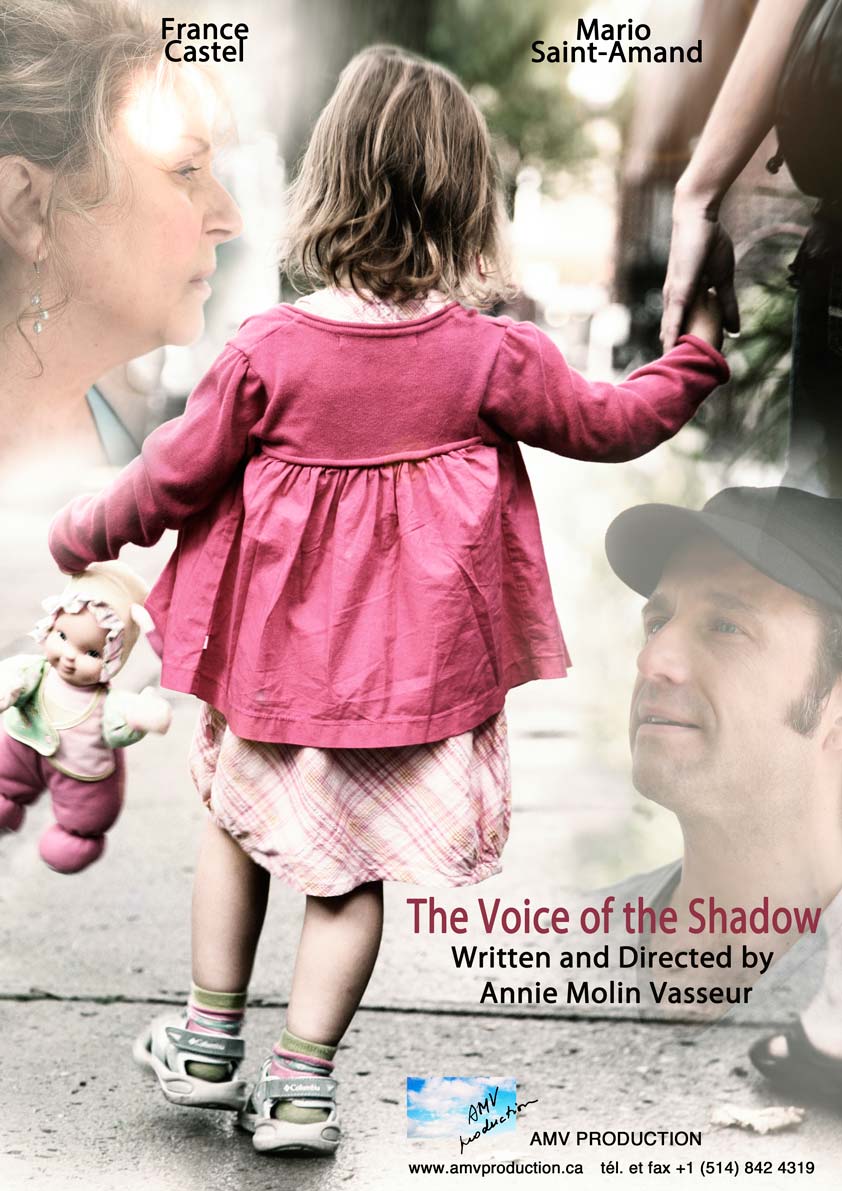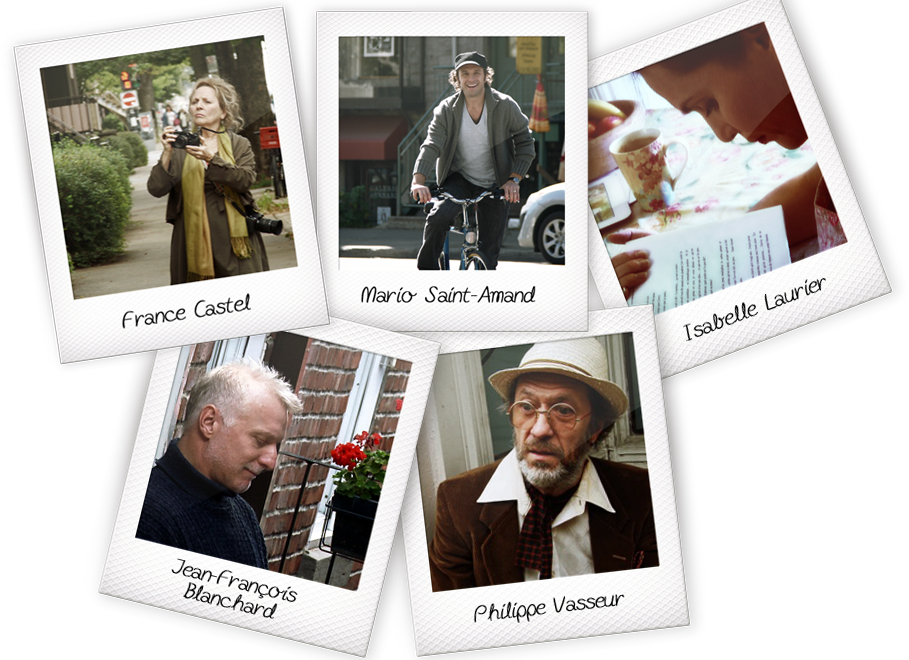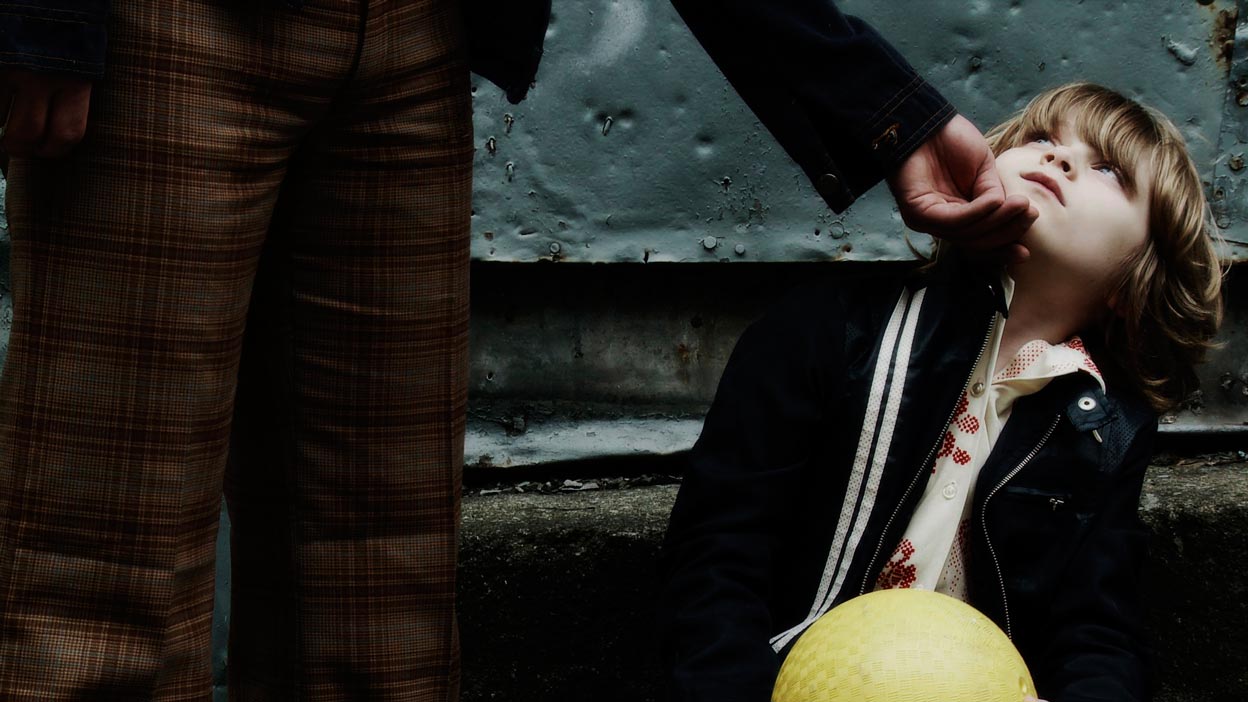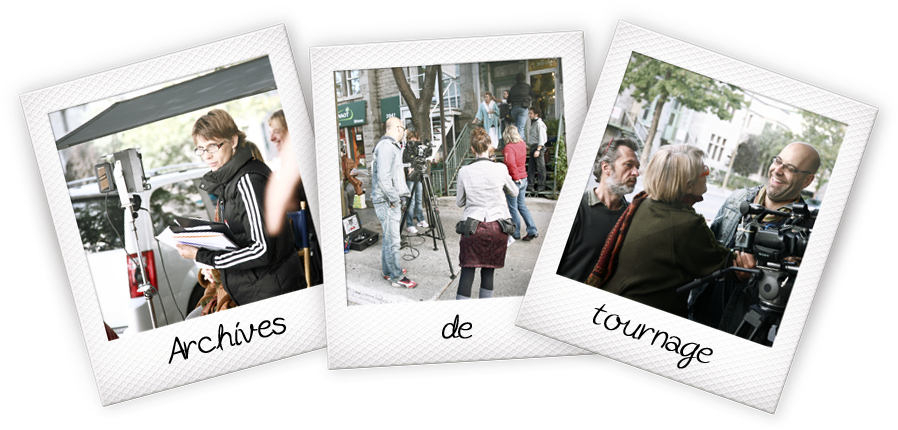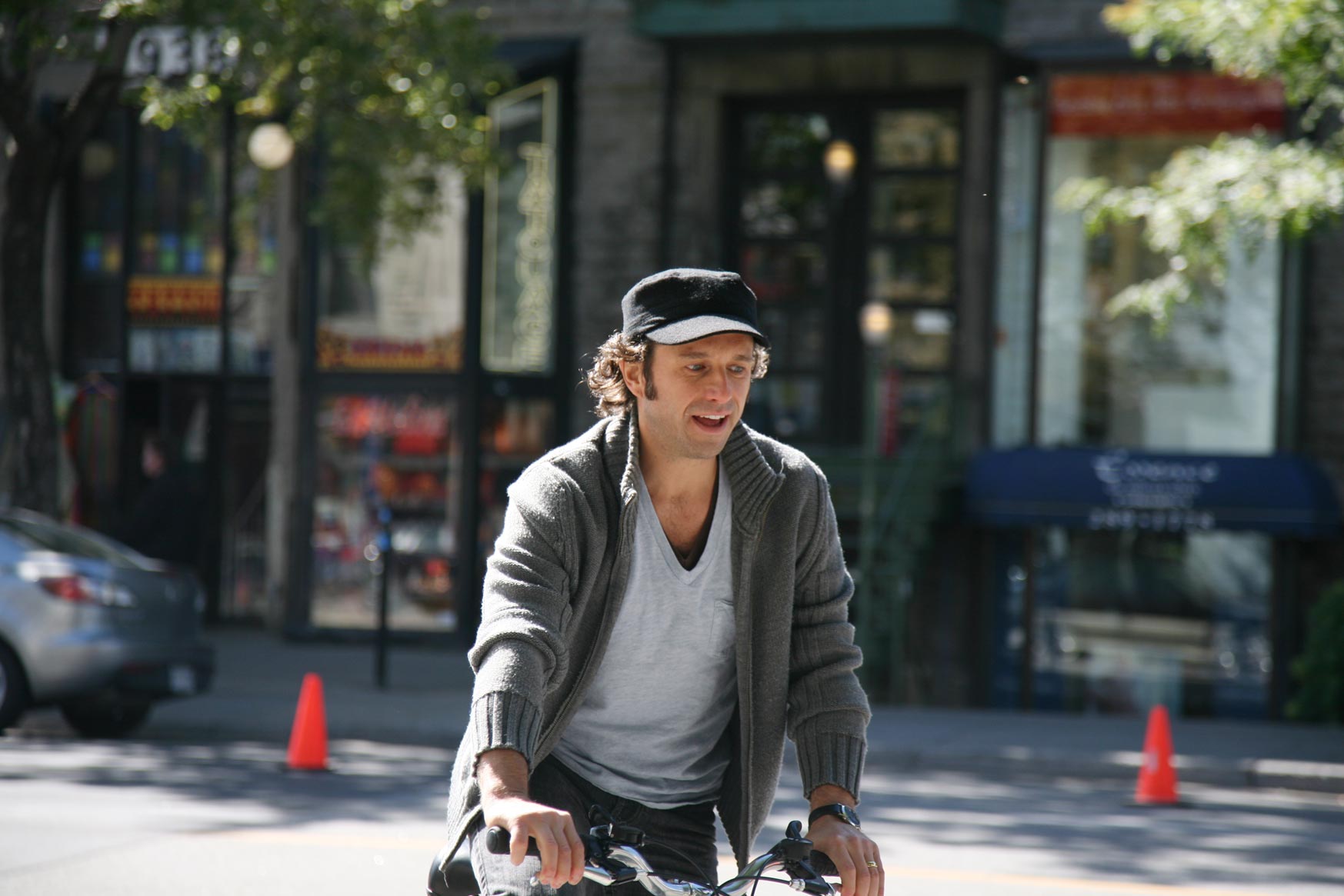THE VOICE OF THE SHADOW
FRANCE CASTEL
MARIO SAINT-AMAND
ISABELLE LAURIER
JEAN-FRANÇOIS BLANCHARD
PHILIPPE VASSEUR
LA VOIX DE L’OMBRE / THE VOICE OF THE SHADOW
FEATURE FILM from ANNIE MOLIN VASSEUR – CANADA / FRANCE 2013-83 MINUTES
MARIE-HÉLÈNE and THOMAS have been lovers for five years now, in Montreal, where they each have their own apartment. She lives alone, and he lives with his wife, GISÈLE and their daughter, CLAIRE.
Thomas has a bicycle accident and goes into a coma. Marie-Hélène finds out through JOHN her ex-lover and Thomas’s friend. Though Thomas and Marie-Hélène have recently split up, she goes to visit him in the hospital
each day, when his wife is not there. Convinced that he can hear her, and to keep him interested in life, Marie-Hélène describes to him moments and gestures from her encounters with the people in the street that she photographs. She pleads with him to come out of the coma. Day by day, she weaves a thread inside of Thomas that becomes his lifeline to memory and creativity.
Through Marie-Hélène’s photographs and tales, we encounter varied colorful characters. Humorous and sad scenes from daily life are cut with reminders of Marie-Hélène’s and of Thomas life together, and flashbacks to earlier moments they once shared.
A voice, that of MARIE-HÉLÈNE’s MOTHER, reads excerpts from a book she read in the past, conveys part of the disturbing Voice of the Shadow linking childhood memories to the dramatic past of the characters.
Press book : Press book (english version)
La bande amorce
Reading of the film by Guy Magen, semiologist, producer Damien Jarnac, BAAM, France
Trailer
Director’s note
Facing a coma (the representation of a wounded environment that is the reflection of our society) in a bleeding, amnesiac present looking towards a future with no horizon, can a woman whose youth is well behind her believe that sharing the little events of day-to-day living will sustain the life force of a consciousness that appears to be disconnected. Can she believe that a romance coming late in life—hard to compare to the bursting fireworks of youthful passion—will have the strength to colour existence with an aura of tenderness while regenerating a presence in the world out of absence? What is this voice of the shadow, diaphanous and multitudinous, that insinuates itself into memory and recalls the past history of Marie-Hélène and Thomas? These characters do not seem torn up by what they are experiencing, although their experience is a melodrama in which the past rises to the surface. Will there be acceptance? Resilience? The wisdom that can reduce to nothingness any and all acts of revolt, even if it is true that indignation knows no age? What marks has “epi-genesis” left on their lives, and what force engenders a belief in life and creation? What do poetry and love represent here? Are the characters risking their hide?
These questions were the primary driving force behind the script for La voix de l’ombre (The Voice of the Shadow), which I began writing in 2008. Having come to film directing in 2007, self-taught, as I was for all disciplines that I had previously taken on, I did not approach the act as a stylistic exercise. This, my first feature-length film, does not seek to adhere to a pre-established form, though certain renegade forms of questioning from my writing do run through it—namely, the overlapping of layers of memory and facts that shatter the story’s timeframe, giving way to a more random, inward timeframe. For me, the voice of the shadow— La voix de l’ombre—is perhaps this rising-up of memories of films from the early days, with their melodramas, their double exposures, and their calls to dreaming and introspection.
In a word, after the many difficulties overcome to produce this film, and with the wisdom of hindsight, this film could not have been anything but what it is. Questions remain for me to share, and a cinematographic path beckons to me.
Credit
DISTRIBUTION (World less France)
(Monde moins la France) AZ FILMS, Montréal
DISTRIBUTION (France)
(France) AMV DISTRIBUTION, Paris
Marie-Hélène
France Castel
Marie-Hélène age 27
Isabeau Blanche
Marie-Hélène ado
Sarah-Ève Grandmaison
Marie-Hélène age 5
Émilie Bierre
Marie-Hélène age 3
Charlotte Giraldeau
Thomas
Mario Saint-Amand
Thomas age 17
Francis Tremblay
Thomas age 7
Léo Deslauriers
Little girl age 3
Juliette Bierre
Boy age 3
Charles William Ross
Boy age 8
Frédéric Brault
Boy age 10
Marc-Antoine Foucault
Marie-Hélène’s Mother
Isabelle Laurier
John
Jean-François Blanchard
The Benchman
Philippe Vasseur
Gisèle
Isabelle O’Brien
Claire
Laetitia Isambert-Denis
Tapistry-maker.
Mylène Savoie
Bandit and man on bridge
Gabriel Paré
Thomas’s Father
Maxime Laurin
Presenter
Isabelle Paré
Marie-Hélène’s mother’s friend
Manon Brunet
Thomas’ s father ‘s accomplice
Antoine Portelance
Nurse Irina
Martina Govednik
Beggar.
Nicolas Chabot
Hospital’s assistant
Valérie Cantin
Doctor
Paul Stewart
Young woman.
Meliza Lejeune
Written and Directed by
Annie Molin Vasseur
Cinematography
Nicolas Venne & Abbey Neidik (2nd unit)
Film editing
Philippe Vasseur & Annie Molin Vasseur
Supervisor Film editing
Natacha Dufaux
Assistant Film editing
Salomé Dufaux Mathieu
Online editing
Sébastien Ventura
Music
Justin Béchard & Patrick Spisak
Sound concept
Georges Forget
Sound editing and mix
Louis Haeri
Colorist
Marc Desborde
Assistant Director
Catherine Lachance & Maud Boisnard (2nd unit)
3rd Assistant Director
Daniella Jovanovic & Catherine Szabo
Continuity
Nathalie Bayle
Assistant interactive writting
Nathalie Roy
Artistic director
Marie-Ève Bolduc
Artistic director’s assistants
Julie Chamberland, Anette Belley & Philippe Vasseur
Production manager
Marc Cunningham
Production coordinator
Geneviève Joly
Postproduction manager
Gérard Jongis
Postproduction advisor
Pierre Thériault
Preproduction
Davy Derouault & Nadine Demeule
Sound engineer
Philippe Scultéty
Boom operator
Julien Gabillaud
Lighting
Simon Lamarre-Ledoux
Lighting technicians
Xavier Boisvert & Yannick Vigier
TGDN/1st assistant camera
Olivier Arends Leblanc
Costumes, dresser.
Noémi Poulin
Assistants dresser
Maria Pasik & Audrey Chikhani
Chief make-up artista
Jean-Sébastien Ouellet
Make-up effects
Ève Monnier
Chief hairdresser
Richard Hansen
Set photographer
Yves Medam
Archival photos
Pierre Crépô, Nicolas Venne & Annie Molin Vasseur
Casting, extras
Carole Dionne
Exterior locations Manager.
Marie-José Bernard
Assistant locations Manager.
Virginia Leurent De Wavrin Bonnevie
Production assistants
Jim Lévesque & Kevin Bujold
Driver
Martin Letendre
Song Quand on y pensé
Groupe Renuvo
Piano performer Satin
Guillaume Dubois
Poem C’est à vous que je parle.
(Éditions Caractères, Paris, 2014)
Annie Molin Vasseur
Poem reader
Isabelle Laurier
Visual art works:
Georges Autard
Denis Demers
Serge Lemoyne
Louise Paillé
Jean-Luc Poivret
Ody Saban
Francine Simonin
Judith Wolfe
Translation
Margaux Ouimet (sous-titres en anglais)
Mark Stout (poème C’est à vous que je parle, en anglais)
Catering
Landry Maltraiteur
Producer
Annie Molin Vasseur
Thanks to :
Mathieu Demers
Jacques Frigon
Michel Giroux
Catherine Grégoire
Hamid Hoveyda
Francine Larivée et Claude Grenier
Huguette Le Gall
Véronique Marino
Jean-Michel Molin
Thierry Paradis
Ginette Petit
Yvon Rivard
Joël Serra
Christelle Le mas de Provence
UDA
AQTIS
APFTQ
CINEPOOL
DÉPARTEMENT CAMÉRA
CINÉMATHÈQUE QUÉBÉCOISE
STUDIO WOMBAT
Productions Murmures
Cent visages de la figuration
UN FILM D’ANNIE MOLIN VASSEUR
visa d’exploitation no 139.316
© AMV PRODUCTION – 2013
Biographies
France Castel is by turns a singer, an actress and a talk-show host. She is quite well-known to television viewers who are accustomed to seeing her on many different shows, year after year: «Prozac», «Ramdam», «Lance et compte», «Les Super Mamies», «L’Or», «La part des anges», «Omerta», «Le Volcan tranquille», «Urgence», «Sous un ciel variable», and «Scoop», to name but a few. Her film work includes roles in a score of movies, including «Je me souviens», «Les 3 P’tits cochons» (The 3 Little Pigs), «La Lune viendra d’elle-même», «Karmina», «La Comtesse de Bâton Rouge», «Une histoire inventée», «Coteau rouge», and «Sur le rythme» by up-and-coming director Charles-Olivier Michaud. Her theatre credits include «Les Girls à Clémence», «La mort d’un commis voyageur» (Death of a Salesman), and «Demain matin Montréal m’attend». More recently, she has graced the stage in a number of summer theatre productions.
Since she hosted «Deux filles le matin» with France Beaudoin and «Droit au cœur» on Radio Canada, we have witnessed how all facets of France Castel’s life have contributed to her qualities as a talk-show host. Her generous nature, her ability to listen, her vibrant presence, and her infectious laugh are all traits that make her eminently qualified to take the helm of the program «Pour le plaisir».
For over 20 years, Mario Saint-Amand has been offering up the fruits of his gifts as an actor in roles as varied as they are intense in both film and television. His film career began in 1989 in the film «Love-moi», directed by Marcel Simard, a film that deals with juvenile delinquency. We were then able to appreciate his talent in «L’automne sauvage» and «Karmina», both directed by Gabriel Pelletier. In the fall of 2007, André Forcier offered him a role in «Je me souviens». And in 2009, under the direction of Julien Knafo, he played a young father troubled by his past in the film «Lucidité passagère».
In 2011, he landed a major role, playing Gerry Boulet in the film «Gerry», directed by Alain Desrochers. He then performed in «Coteau Rouge» with André Forcier. In 2011 and 2012, he took part in a theatrical creation staged by Dominic Champagne entitled «Tout ça m’assassine» before going on tour in Quebec with his production of Mario Saint-Amand music, «On passe nos blues».
Isabelle Laurier is an actress who dances, sings, and writes. She has performed in a variety of plays, including «Les Amants du Métro» and «L’Œuf». Her preferred medium is film. She has had roles in a score of short films and nearly 10 feature-length films. She appeared in «Piché» «entre Ciel et Terre», «Gerry», «The Girl with the White Coat», and «The Year Dolly Parton Was My Mom». She played the leading role in «L’Éclosion», «Les Traits», «Chimériques», «Les Cicatrices», and «Mille Images valent un Mot», among other films.
Isabelle is also a musician and has studied and plays several musical instruments, among them the piano, the oboe, and the guitar. She has danced classical ballet as well as modern jazz, hip-hop, and salsa; and she sings jazz, rock, and varieties.

